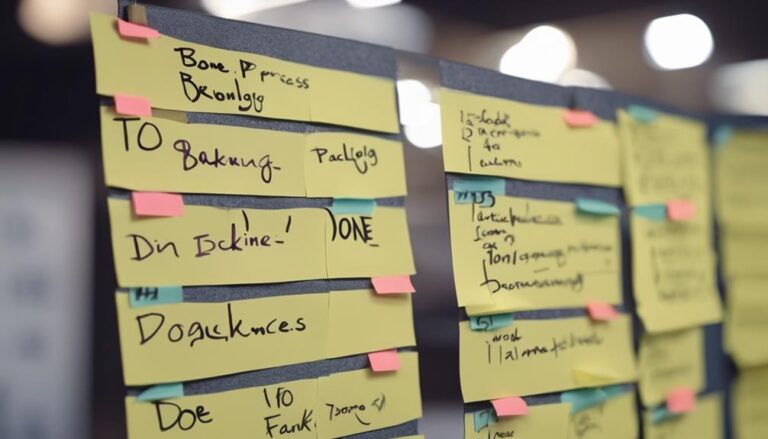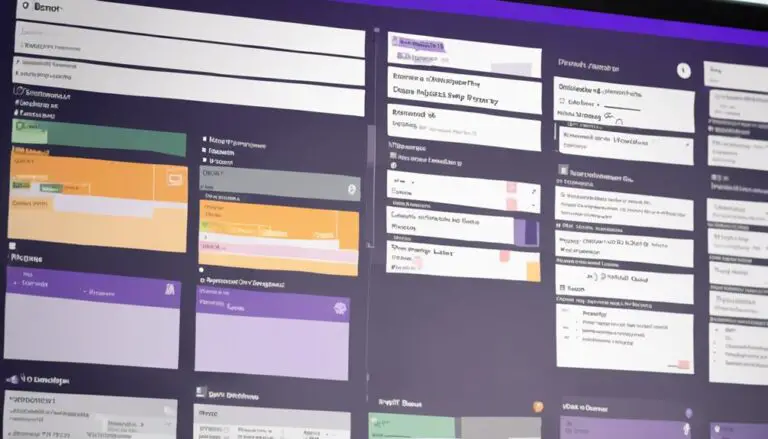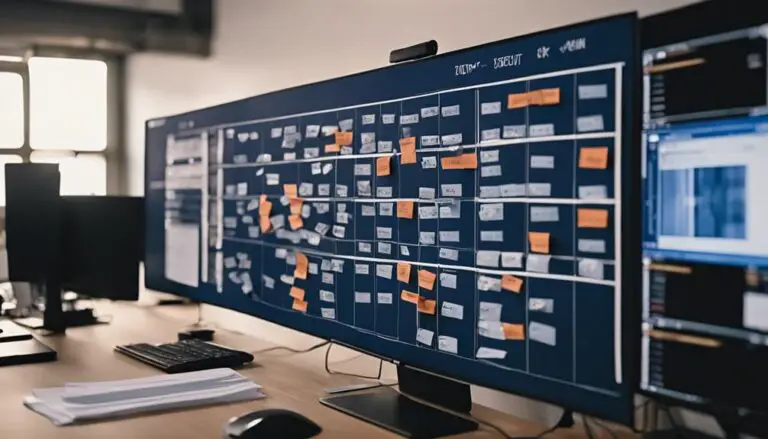You've likely heard of Kanban and Scrum as two separate project management methodologies. However, have you ever considered the power they hold when combined?
The synergy between Kanban and Scrum can revolutionize the way your teams approach project management, leading to increased efficiency and collaboration. But how exactly can the integration of these two frameworks transform your project outcomes?
Let's explore the intricacies of leveraging Kanban and Scrum in unison and discover the untapped potential they offer for enhancing your project management practices.
Key Takeaways
- Enhance project management through collaboration and transparency.
- Optimize workflow with structured sprints and continuous improvement.
- Utilize Kanban boards for visualizing progress and limiting work in progress.
- Drive project success by combining Scrum's teamwork and Kanban's efficiency.
Benefits of Kanban and Scrum
By combining the Kanban and Scrum methodologies, you can unlock a myriad of benefits that streamline project management processes and enhance team productivity. Kanban excels in visualizing workflow stages and tasks on a board, promoting continuous improvement and adaptation to changes swiftly. It focuses on optimizing workflow and ensuring continuous task delivery, which complements Scrum's structured sprints and iterative improvements delivered in fixed periods. Together, these methodologies create a synergy that enhances team collaboration, transparency, and efficiency in project delivery.
Teams adopting this combined approach benefit from the flexibility of Kanban and the structured framework of Scrum. Kanban allows teams to visualize their work, identify bottlenecks, and continuously adapt to improve their processes. On the other hand, Scrum provides clear roles, sprint goals, and a cadence for delivering value in short cycles. This combination not only enhances project management but also fosters a culture of continuous improvement and efficiency within the team, ultimately leading to successful project outcomes.
Implementing Kanban in Project Management
When implementing Kanban in project management, focus on visualizing workflow for efficiency and limiting work in progress to enhance productivity.
Setting up a Kanban board, adding tasks in manageable pieces, and moving tasks through stages are key initial steps to streamline your project management process.
Visualizing Workflow for Efficiency
How can visualizing workflow stages using a Kanban board enhance efficiency and transparency in project management?
By implementing Kanban boards, you can:
- Track Progress: Visualize tasks as they move through workflow stages, allowing for easy monitoring of progress and identification of bottlenecks.
- Enhance Communication: Utilize color coding for task categorization and conduct regular stand-up meetings to ensure everyone is in sync and updated.
- Optimize Workflow: Simplify task management by setting WIP limits, tracking completed tasks, and maintaining a steady flow of work to improve efficiency and transparency.
Implementing Kanban ensures tasks flow smoothly, enabling continuous improvement and efficient project delivery.
Limiting Work in Progress
Implementing Kanban in project management involves strategically setting Work In Progress (WIP) limits to optimize workflow efficiency and enhance team productivity. By implementing WIP limits, Kanban practices ensure a smooth workflow by preventing overloading and identifying bottlenecks in the process. These limits help teams focus on completing tasks before starting new ones, reducing multitasking and improving lead times.
Setting WIP limits encourages team collaboration, increases productivity, and maintains a steady flow of work throughout the project. Monitoring and adjusting WIP limits lead to better resource utilization, improved quality, and timely delivery of project tasks. Embracing WIP limits in Kanban not only streamlines the workflow but also fosters a culture of efficiency and continuous improvement within the team.
Leveraging Scrum for Project Success
To leverage Scrum effectively for project success, ensure clear roles and responsibilities are defined within the team to promote collaboration and accountability. Here are three key strategies to help you maximize the benefits of Scrum for your projects:
- Establish Structured Sprints: Divide your project into structured sprints lasting 1-4 weeks to maintain focus, adapt quickly to changes, and deliver value incrementally.
- Embrace Continuous Improvement: Encourage the team to reflect on their processes regularly through events like sprint reviews and retrospectives to identify areas for enhancement and drive continuous improvement.
- Foster Collaboration: Create a culture that values open communication, transparency, and teamwork. Empower team members to work together towards shared goals, leveraging their diverse skills and perspectives for project success.
Key Principles of Kanban
When implementing Kanban, you should focus on visualizing your work progress by using a board with columns and task cards. Limiting your Work in Progress (WIP) is crucial for optimizing efficiency and productivity.
Embracing a continuous improvement mindset aligns with Kanban's principles for incremental enhancements.
Visualize Work Progress
Visualizing work progress through a Kanban board is a fundamental principle that enhances transparency, communication, and workflow optimization in project management. When utilizing Kanban, you can benefit from the following:
- Visual Board: The visual representation of tasks on a Kanban board allows for easy tracking of work progress.
- Columns: Different stages of tasks are represented by columns, providing clarity on where each task stands in the workflow.
- Efficiency: By visualizing work progress, teams can identify bottlenecks, optimize their workflow, and enhance efficiency in project management.
Embracing Kanban's visual nature not only fosters transparency but also facilitates smoother communication and improved project outcomes.
Limit Work in Progress
Limiting Work in Progress (WIP) in Kanban is a foundational practice that drives focus, efficiency, and continuous workflow improvement in project management. By setting WIP limits aligned with team capacity and workflow constraints, you ensure tasks are completed before taking on new ones, reducing multitasking and enhancing productivity.
These limits help prevent overburdening, identify bottlenecks, and maintain a steady flow of work. Visual cues indicate when to pull in more tasks, balancing workloads and promoting smoother workflows. Embracing WIP limits in Kanban encourages timely task completion, leading to quicker deliveries and improved quality outcomes.
Effectively managing WIP ensures work moves steadily through the workflow, enhancing predictability and optimizing project timelines.
Continuous Improvement Mindset
Embracing the continuous improvement mindset in Kanban involves fostering a culture of learning and evolving processes to drive better outcomes. By integrating Agile values and following Kanban principles like 'Kaizen,' teams can continuously enhance their project management approach.
Here's how to cultivate this mindset effectively:
- Visualizing Workflow: Utilize visual boards to track tasks and progress transparently.
- Limiting Work in Progress: Focus on completing current tasks before taking on new ones to improve efficiency.
- Actively Managing Flow: Monitor and adjust workflow to maintain a steady pace and optimize productivity.
Scrum Roles and Responsibilities
In the Scrum framework, distinct roles with specific responsibilities are crucial for effective project management. The Product Owner plays a pivotal role in maximizing the product's value and managing the product backlog. Their responsibilities include prioritizing tasks based on business value and ensuring clear communication between the team and stakeholders.
The Scrum Master, on the other hand, acts as a facilitator, guiding the team through the Scrum process, removing impediments, and promoting adherence to Scrum principles. This role fosters collaboration and ensures that the team stays focused on the project goals.
The Development Team, comprising self-organizing and cross-functional members, is responsible for delivering potentially shippable product increments. Their main focus is on turning the items from the product backlog into a working product.
Together, these roles work in harmony, promoting transparency, collaboration, and efficiency throughout the project lifecycle.
Continuous Improvement With Kanban
Utilize Kanban's methodology to drive continuous improvement by visualizing workflow and identifying bottlenecks effectively. Kanban offers a structured approach to enhancing project management through continuous improvement. Here's how you can leverage Kanban for optimizing workflow:
- Limit Work in Progress (WIP): By restricting the number of tasks in progress, Kanban encourages teams to focus on completing existing work before taking on new tasks. This helps in maintaining focus and improving overall efficiency.
- Utilize Flow Metrics: Kanban emphasizes the use of flow metrics like cycle time and throughput to measure and analyze the team's performance. By tracking these metrics, teams can identify bottlenecks, streamline processes, and enhance productivity.
- Optimize Workflow: Through visualizing workflow and utilizing Kanban boards, teams can optimize their workflow for better efficiency and predictability. Regularly inspecting and adapting practices based on Kanban principles leads to sustained improvements in project delivery.
Kanban Board Setup
To set up an effective Kanban board for your project management needs, begin by visually mapping out the workflow stages with clear columns representing task progression. Divide the Kanban board into columns that reflect the various stages your tasks go through, such as 'To Do,' 'In Progress,' and 'Done.'
Each task is then depicted by a card that moves across these columns as progress is made. Setting Work in Progress (WIP) limits for each column helps in maintaining focus and preventing overload at any stage. Utilize color coding on the cards to categorize tasks or signify priority levels, enhancing visual organization.
Agile Practices With Scrum
Structured around iterative sprints and key ceremonies, Agile Practices with Scrum provide a framework for efficient project management and continuous improvement. Here's what you need to know:
- Sprint Structure: Scrum emphasizes structured sprints lasting 1-4 weeks with defined planning, review, retrospective, and daily standup meetings, ensuring clear goals and regular communication within the team.
- Role Clarity: Roles in Scrum, including the product owner, scrum master, and development team, come with specific responsibilities, fostering accountability and collaboration among team members.
- Metric Focus: Key metrics in Scrum such as sprint goals, velocity, capacity, and work type are crucial for measuring progress and performance, enabling teams to track their efficiency and adapt their processes for continuous improvement.
Incorporating Agile practices with Scrum not only enhances project management but also fosters a culture of collaboration, adaptability, and learning within software development teams. Embrace these methodologies to drive better outcomes and deliver value consistently.
Monitoring Progress in Scrum
Monitoring progress in Scrum involves utilizing Sprint Burndown charts, Daily Stand-up meetings, updated Product Backlog items, Sprint Retrospectives, and transparent artifacts to track and assess project advancement effectively.
The Sprint Burndown charts provide a visual representation of remaining work throughout the sprint, aiding in understanding if the team is on track to meet sprint goals.
Daily Stand-up meetings allow for quick updates on progress, discussing any roadblocks, and making necessary adjustments to stay aligned.
Regularly updating Product Backlog items ensures that progress and changes in project requirements are reflected accurately.
Sprint Retrospectives offer a platform for the team to review progress, identify areas for improvement, and adapt for future sprints.
Scrum emphasizes transparency and visibility through artifacts like Sprint Backlogs and Increment reviews, ensuring that all team members have a clear understanding of the project's status and direction.
Frequently Asked Questions
How Do I Use Scrum and Kanban Together?
To combine Scrum and Kanban effectively, you prioritize tasks, optimize workflows, and foster Agile collaboration for team efficiency. Incorporate daily standups, backlog grooming, and continuous improvement practices to enhance Agile development and streamline processes.
What Are the Benefits of Kanban and Scrum Methodology in Managing a Project?
To manage a project effectively, embrace Kanban and Scrum. Benefit from increased efficiency, improved collaboration, visual workflow, enhanced transparency, faster delivery, better prioritization, continuous improvement, and reduced bottlenecks. These methodologies pave the way for project success. By combining the strengths of both methodologies, scrum and kanban synergy can be achieved. This allows for a more holistic approach to project management, leveraging the unique advantages of each method to achieve even greater results. By embracing both Kanban and Scrum, project teams can benefit from the flexibility, adaptability, and efficiency that these two methodologies offer, leading to more successful project outcomes.
Which Project Management Framework Combines Scrum and Kanban?
A hybrid approach that integrates Scrum's structured sprint cycles with Kanban's agile integration of workflow optimization is Scrumban. It combines Scrum boards and Kanban cards for continuous improvement and emphasizes team collaboration in project management.
How Do You Establish Flow With Scrum and Kanban?
To establish flow with Scrum and Kanban, you visualize work, limit WIP, and structure iterations. By combining these methods, you enhance transparency, efficiency, and collaboration, fostering continuous improvement through iterative development, feedback loops, and actively managing workflows.
Conclusion
In conclusion, combining Kanban and Scrum can bring clarity, collaboration, and consistency to your project management approach.
By visualizing work, limiting WIP, and tracking key metrics, teams can streamline processes and improve productivity.
With a clear Kanban board setup and agile practices in place, you can monitor progress in real-time and drive continuous improvement.
Embrace the power of Kanban and Scrum to enhance your project delivery and achieve success through strategic workflow optimization.





